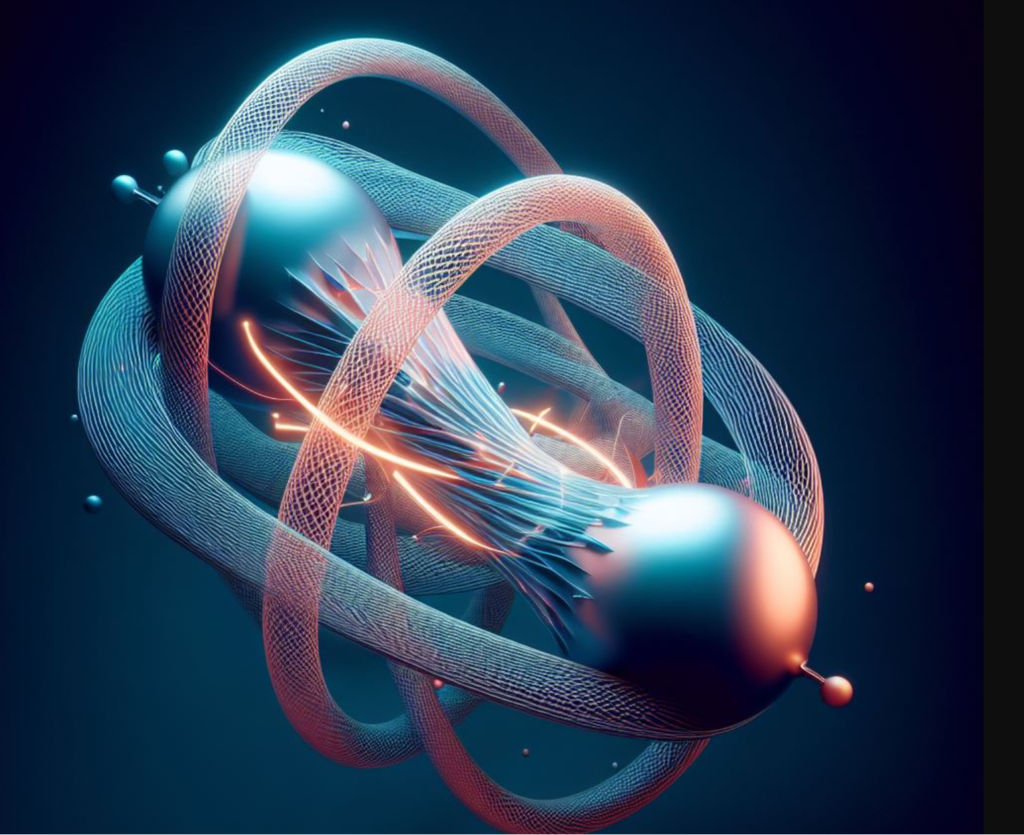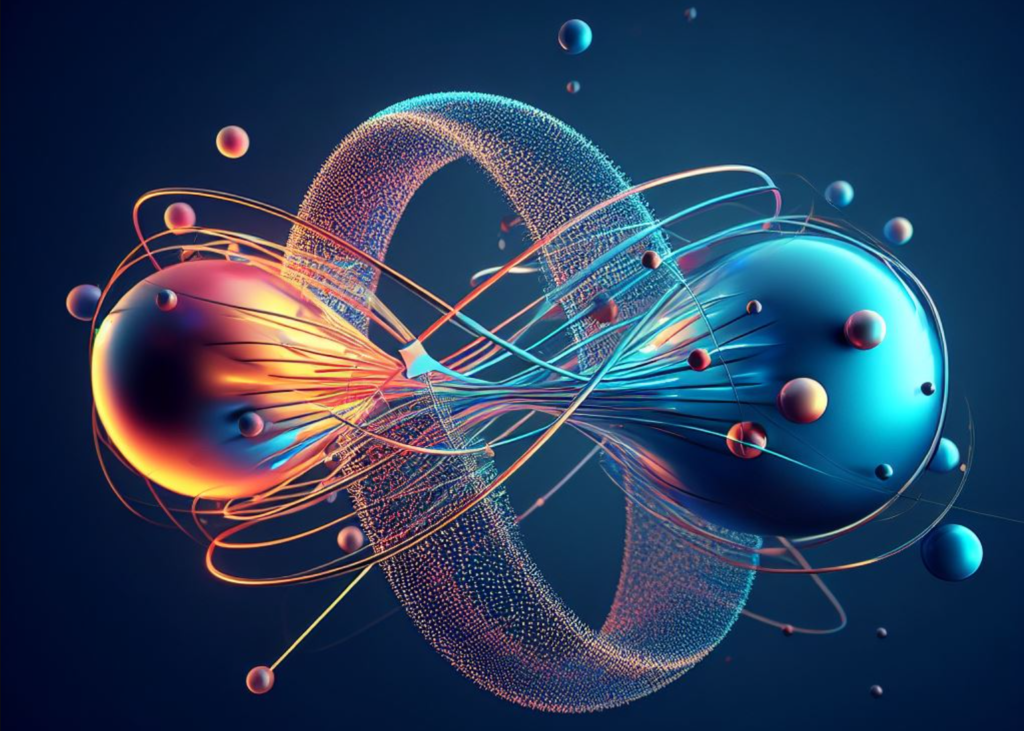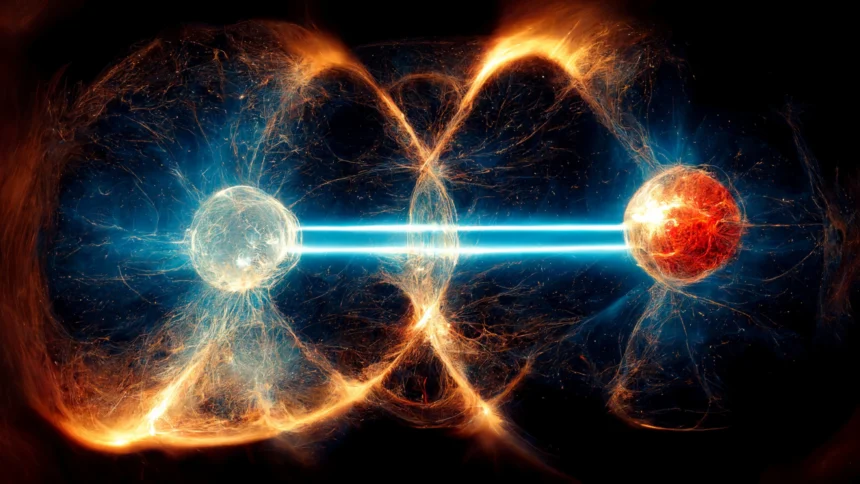Introduction
Quantum physics, the branch of science that explores the baffling behavior of the smallest particles in the universe, often challenges our classical intuition. One of the most puzzling phenomena in this realm is entanglement, where two particles become interconnected in such a way that the properties of one are instantaneously linked to the other, even if they are separated by vast distances. In this article, we delve into the fascinating concept of “double entanglement,” a mind-bending extension of quantum entanglement.
Understanding Quantum Entanglement:Quantum Physics

Quantum Physics
Before we explore double entanglement, it’s essential to grasp the basics of quantum entanglement. When two particles, such as electrons or photons, are created together, they can become entangled. This means that certain properties of one particle, like its spin or polarization, are intrinsically linked to the other, and measuring one particle instantaneously determines the corresponding property of the second, regardless of the distance between them. This connection seems to defy the constraints of space and time.
Also read :The Great Cosmic Void: What Keeps Space Empty?
The Quantum Duet: Entangled Particles
In a typical entanglement scenario, two particles are entangled, and measuring one influences the state of the other. For instance, if you measure the spin of one entangled particle and find it to be “up,” the other particle’s spin will be determined as “down,” regardless of how far apart they are.
The Enigma of Double Entanglement

Quantum Physics
Double entanglement takes this already perplexing concept a step further. In this scenario, two pairs of entangled particles are involved. Each pair is entangled with the other pair. This creates a complex web of entanglement relationships, where the state of one particle in each pair is connected to the state of one particle in the other pair. If you measure one particle from the first pair, it instantly influences the state of its entangled partner in the other pair, and vice versa.
The EPR Paradox and Double Entanglement
Double entanglement was initially explored in the context of the EPR paradox, named after Einstein, Podolsky, and Rosen, who proposed it in a famous 1935 paper. The EPR paradox illustrated that, according to the principles of quantum mechanics, two entangled particles could instantaneously influence each other’s properties, which seemed to violate the speed-of-light limit imposed by special relativity.
Double entanglement takes the EPR paradox to the next level. It demonstrates that not only are two particles entangled, but their entanglement is interconnected with another pair of entangled particles. This creates a cascade of influence that spans multiple particles, with each measurement having a far-reaching impact.
Applications and Implications

The phenomenon of double entanglement, like single entanglement, has far-reaching implications for the field of quantum computing, cryptography, and communication. It challenges our understanding of the fundamental nature of reality, suggesting that particles can be interconnected in ways that defy classical logic.
Understanding double entanglement and its intricacies is a work in progress for scientists and researchers in the field of quantum physics. As they unravel the mysteries of this phenomenon, it opens the door to new possibilities in harnessing the power of quantum mechanics for future technologies.
Conclusion
Double entanglement is a testament to the mind-bending nature of quantum physics. It extends the already mystifying concept of entanglement by interweaving multiple pairs of entangled particles. While the full implications of double entanglement are still being explored, it underscores the rich complexity and potential of the quantum world. As we continue to probe the depths of quantum physics, we may discover even more astonishing phenomena that challenge our perceptions of reality and open doors to revolutionary technological advancements.
FAQ: Double Entanglement in Quantum Physics
- What is quantum entanglement? Quantum entanglement is a phenomenon in quantum physics where two or more particles become interconnected in such a way that the properties of one particle are instantaneously linked to the properties of the other(s), regardless of the distance between them.
- How does double entanglement differ from single entanglement?Double entanglement involves two pairs of entangled particles, with each pair being entangled with the other. This creates a complex web of interconnected particles, where the state of one particle in each pair influences the state of a particle in the other pair, and vice versa.
- What is the EPR paradox, and how is it related to double entanglement?The EPR paradox, proposed by Einstein, Podolsky, and Rosen, illustrated that two entangled particles could instantaneously influence each other’s properties, seemingly violating the speed-of-light limit imposed by special relativity. Double entanglement extends the concept by interconnecting two pairs of entangled particles.
- Are there practical applications for double entanglement?Double entanglement, like single entanglement, has implications for quantum technologies, including quantum computing and cryptography. It challenges our classical understanding of the fundamental nature of particles and can lead to revolutionary advancements in these fields.
- Can double entanglement be harnessed for faster-than-light communication?While double entanglement and quantum entanglement in general can appear to involve faster-than-light effects, they do not allow for practical faster-than-light communication. The concept of entanglement remains a subject of scientific study and does not enable superluminal (faster-than-light) communication.
- How is double entanglement relevant to our understanding of quantum mechanics?Double entanglement challenges our classical understanding of the separability and independence of particles. It highlights the non-intuitive nature of quantum mechanics and the rich complexity of quantum systems, shedding light on the interconnectedness of particles in the quantum realm.
- What are some potential future developments or discoveries related to double entanglement?Research in the field of quantum physics is ongoing, and scientists continue to explore the implications and applications of double entanglement. New discoveries may reveal even more profound insights into the behavior of entangled particles and their potential technological uses.
- Are there real-world examples or experiments demonstrating double entanglement?While theoretical discussions of double entanglement exist, it is a complex and abstract concept that has not yet been widely demonstrated in practical experiments. Quantum physics researchers are working on experiments to further explore and understand the phenomenon.
Also read :Are There Any Parts Of The Human Body That Get Oxygen Directly From The Air And Not From The Blood?




































